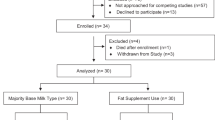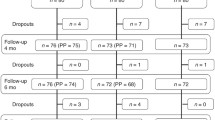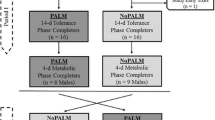Abstract
The effect of different diets on the percentage content of long-chain polyunsaturated fatty acids (LCP; metabolites of linoleic and alpha-linolenic acids) in plasma lipids was studied in 29 premature infants on days 4 and 21 of life. Eleven infants were fed human milk which supplies LCP (1.7% of the fatty acids), 10 a commercially available milk formula without LCP, and 8 a new formula enriched with LCP of the omega-6 and the omega-3 series (0.5% LCP). LCP values in plasma lipids remained stable during the observation period in infants fed human milk. In contrast, LCP decreased markedly in plasma lipids of infants fed the conventional formula. Since the precursor fatty acids linoleic and alpha-linolenic acids were high in their diet and plasma, this finding indicates that premature infants have a limited capacity for LCP biosynthesis and may require their dietary supplementation. Infants fed the LCP enriched formula had significantly higher LCP proportions in plasma lipids than infants given the conventional formula, but less than infants fed human milk. Our results demonstrate that small concentrations of dietary LCP have marked effects on plasma lipid composition, particularly on phospholipids, suggesting that dietary LCP are preferentially channelled into structural lipids. We conclude that the essential fatty acid status of formula-fed premature infants can be improved by a supplementation of omega-6- and omega-3-LCP.
Similar content being viewed by others
Abbreviations
- LCP:
-
long-chain polyunsaturated fatty acids
References
Ballabriga A, Martinez M (1976) Changes in erythrocyte lipid stroma in the premature infant according to dietary fat composition. Acta Paediatr Scand 65:705–709
Brenner RR (1974) The oxidative desaturation of unsaturated fatty acids in animals. Mol Cell Biochem 3:41–52
Carlson SE, Rhodes PG, Ferguson MG (1986) Docosahexaenoic acid status of preterm infants at birth and following feeding with human milk or formula. Am J Clin Nutr 44:798–804
Carlson SE, Rhodes PG, Rao VS, Goldgar DE (1987) Effect of fish oil supplementation on the n-3-fatty acid content of red blood cell membranes in preterm infants. Pediatr Res 21:507–510
Chambaz J, Ravel D, Manier MC, Pepin D, Mulliez N, Bereziat G (1985) Essential fatty acid interconversion in the human fetal liver. Biol Neonate 47:136–140
Clandinin MT, Chapell JE, Leong S, Heim T, Swyer PR, Chance GW 1980 Intrauterine fatty acid accretion rates in human brain: implications for fatty acid requirements. Early Hum Dev 4:121–129
Clandinin MT, Wong K, Hacker RG (1985) Synthesis of chain elongation-desaturation products of linoleic acid by liver and brain microsomes during development of the pig. Biochem J 226: 305–309
DeGomez Dumm INT, Brenner RR (1975) Oxidative desaturation of y-linolenic and stearic acids by human liver microsomes. Lipids 10:315–317
Folch J, Lees M, Sloane Stanley GH (1957) A simple method for the isolation and purification of total lipids from animal tissues. J Biol Chem 226:497–509
Heim T (1983) Energy and lipid requirements of the fetus and the preterm infant. J Pediatr Gastroenterol Nutr 2 [Suppl 1] S16-S41
Koletzko B (1986) Essentielle Fettsäuren: Bedeutung für Medizin und Ernährung. Aktuel Endokr Stoffw 7:18–27
Koletzko B, Bremer HJ (1987) Long chain polyunsaturated fatty acids in infant formulae. Eur J Pediatr 146:92–93
Koletzko B, Bremer HJ (1989) Fat content and fatty acid composition of infant formulae. Acta Paediatr Scand (in press)
Koletzko B, Cunnane S (1988) Human alpha-linolenic deficiency? Am J Clin Nutr 47:1084–1086
Koletzko B, Müller J (1989) Cis- and trans-isomeric fatty acids in plasma lipids of newborn infants and their mothers. Biol Neonate (in press)
Koletzko B, Mrotzek M, Bremer HJ (1988) Fatty acid composition of nature human milk in Germany. Am J Clin Nutr 47:954–959
Lamptey MS, Walker BL (1976) A possible essential role for dietary linolenic acid in the development of the young rat. J Nutr 102:86–93
Leyton J Drury PJ, Crawford MA (1987) Differential oxidation of saturated and unsaturated fatty acids in vivo in the rat. Br J Nutr 57:383–393
Liu CCF, Carlson SE, Rhodes PG, Rao VS, Meydrech EF (1987) Increase in plasma phospholipid docosahexaenoic and eicosapentaenoic acids as a reflection of their intake and mode of administration. Pediatr Res 22:297–296
Needleman P, Raz A, Minkes MS, Ferrendelli JA, Sprecher H (1979) Triene prostaglandins: prostacyclin and thromboxane synthesis and unique biological properties. Proc Natl Acad Sci USA 76:944–948
Neuringer M, Connor WE, Van Petten C, Barstad L (1984) Dietary omega-3 fatty acid deficiency and visual loss in infant rhesus monkeys. J Clin Invest 73:272–276
Olegard R, Svennerholm L (1970) Fatty acid composition of plasma and red cell phosphoglycerides in full term infants and their mothers. Acta Paediatr Scand 59:637–667
Olegard R, Svennerholm L (1971) Effects of diet on fatty acid composition of plasma and red cell phosphoglycerides in three-month-old infants. Acta Paediatr Scand 60:505–511
Putnam JC, Carlson SE, De Voe P, Barness LA (1982) The effect of variations of dietary fatty acid composition on erythrocyte phosphatidylcholine and phosphatidylethanolamine in human infants. Am J Clin Nutr 36:106–114
Shires SE, Conway SP, Rawson I, Dear PRF, Kelleher J (1986) Fatty acid composition of plasma and erythrocyte phospholipids in preterm infants. Early Hum Dev 13:53–63
Sinclair AJ (1975) Incorporation of radioactive polyunsaturated fatty acids into liver and brain of developing rat. Lipids 10:175–184
Stoffel W, Chu F, Ahrens EH (1959) Analysis of long-chain fatty acids by gas-liquid chromatography. Anal Chem 31:307–308
Svennerholm L (1968) Distribution and fatty acid composition of phosphoglycerides in normal human brain. J Lipid Res 9:570–579
Yamamoto N, Saitoh M, Moriuchi A, Nomura M, Okuyama H (1987) Effect of dietary a-linolenate/linoleate balance on brain lipid compositions and learning ability of rats. J Lipid Res 28: 144–151
Author information
Authors and Affiliations
Rights and permissions
About this article
Cite this article
Koletzko, B., Schmidt, E., Bremer, H.J. et al. Effects of dietary long-chain polyunsaturated fatty acids on the essential fatty acid status of premature infants. Eur J Pediatr 148, 669–675 (1989). https://doi.org/10.1007/BF00441531
Received:
Accepted:
Issue Date:
DOI: https://doi.org/10.1007/BF00441531




